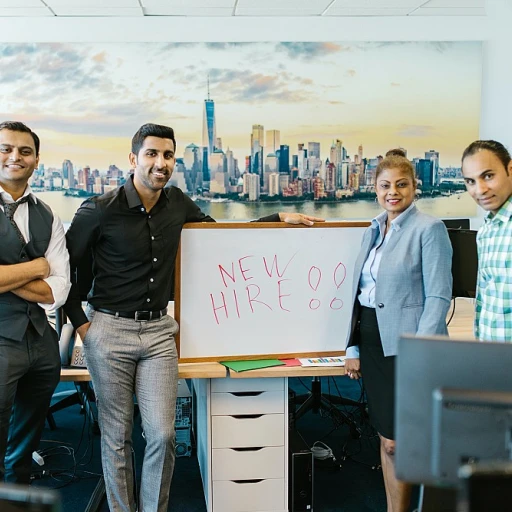Remote Work: A New Normal
Transitioning to a New Way of Working
These days, working from home has become more than just an option for many. It's a new way of life that has cemented itself as the norm for numerous professionals across the globe. The pandemic catalyzed this shift, forcing companies and employees to adapt to a remote-first mindset almost overnight. As a result, the office landscape as we once knew it has evolved dramatically, paving the way for innovative, flexible work arrangements.
The benefits of working remotely are plentiful, ranging from eliminating long commutes to creating opportunities for a better work-life balance. Employees are no longer bound by geographical restrictions, allowing them to work from any corner of the world, provided they have the necessary technology and network connectivity. This newfound flexibility has not only impacted productivity but has also transformed employee expectations and demands.
Moreover, the shift towards remote work has led to an amalgamation of diverse work models, with hybrid systems becoming a popular choice for many organizations. This rise is marked by a blend of remote and on-site work, reflecting a dynamic future full of potential
hybrid work environments.
As we explore what lies ahead for remote work, it's crucial to consider the implications for both employees and employers alike. The shift to remote work brings about unique challenges and opportunities that will shape the future workplace. Stay tuned as we delve deeper into the repercussions and ongoing transformations this new normal carries along in subsequent sections.
The Rise of Hybrid Work Models
The Emergence of Hybrid Work Environments
The landscape of work is rapidly evolving, with a significant focus on blending the advantages of both office-based and remote work. This is where hybrid work models come into play—a flexible structure that is gaining momentum among employers and employees. As organizations continue to adapt, hybrid work arrangements offer a win-win solution, allowing for a balance between collaboration and autonomy.
Hybrid work models are not merely a trend but a strategic approach to satisfy diverse work preferences and increase productivity. Many companies have started implementing policies allowing employees to split their time between working from home and attending the office, suggesting a shift towards this mixed format being a fixture in the modern workplace. As stated in our analysis of
exciting work trends shaping our future, the hybrid model offers employees the convenience of remote work while retaining access to in-person resources and interactions.
For employees, the benefits of this flexibility are clear: improved work-life balance and reduced commuting stress. Yet, for employers, this model can pose challenges, which we'll explore further in the upcoming sections. From ensuring team cohesion to maintaining productivity levels, companies must navigate how to best manage this new dynamic effectively.
Organizations are investing in tools and technologies to facilitate seamless collaboration no matter where employees are working from. Technological advancement is crucial in hybrid environments, with communication platforms and cloud-based solutions playing key roles in bridging physical gaps. Such measures not only support the functional aspects of hybrid work but also contribute to employee satisfaction and retention.
In this transformative era of work, businesses that embrace and refine hybrid work models are likely to remain competitive. The key lies in creating a flexible and inclusive culture where employees feel empowered and connected, whether they are remote or in-office. This shift represents an important step towards the future of work, where adaptability is the driving force behind success.
Impact on Employees and Work-Life Balance
Employee Well-being in Remote Work Environments
The shift to remote work has had a profound impact on employee well-being, with both positive and negative aspects coming into play. One of the most significant benefits is the increased flexibility that remote work offers. Employees are now able to tailor their schedules to better fit their personal lives, leading to improved work-life balance. Many workers find that they have more time to spend with family, pursue hobbies, and focus on personal health and wellness.
However, it's not all rosy. The blurred lines between work and home life can lead to overworking and burnout. Without the clear-cut boundaries of a traditional office environment, employees may find themselves struggling to disconnect after hours. This can be detrimental to their mental health and overall well-being.
Moreover, issues of isolation may arise as remote workers miss out on daily social interactions with colleagues. While technology has bridged some of these gaps with virtual meetings and chats, it's not a perfect substitute for face-to-face communication.
As companies transition towards hybrid work models, they must consider how to support employees' mental and emotional health in both remote and in-person settings. Offering resources for mental health, promoting a culture of open communication, and encouraging regular check-ins can help mitigate some of these challenges. Employers must remain vigilant in addressing the unique obstacles that remote work presents to ensure a healthy and productive workforce.
Challenges for Employers and Businesses
Navigating the Complexities of Remote Work for Employers
As remote work becomes more embedded in our professional culture, employers are faced with a unique set of challenges that require innovative strategies and flexible approaches. Businesses must adapt to the growing demand for remote and hybrid work models, while also ensuring that their workforce remains productive and engaged.
One significant challenge is maintaining effective communication and collaboration among remote teams. Without the traditional office setting, fostering a sense of camaraderie and ensuring seamless information flow can be difficult. Employers need to implement technology solutions and build a virtual culture that promotes interaction and teamwork.
Additionally, performance measurement becomes more complex in a remote work environment. Traditional methods of supervision and evaluation may not be applicable, requiring new metrics and tools to assess productivity based on outcomes rather than physical presence.
Employee mental health and well-being is another critical concern. The blurred lines between personal and professional life in remote work can lead to increased stress and burnout. Employers must prioritize mental health support and promote work-life balance to maintain a healthy workforce.
Data security is another pressing issue. With employees accessing sensitive company information from various locations, ensuring data protection is paramount. Businesses need to invest in robust security systems and remote work protocols to mitigate risks.
Ultimately, organizations must be agile, willing to test new ideas, and open to change to navigate the evolving landscape of remote work effectively. By addressing these challenges head-on, businesses can not only survive but thrive in this new era of work.
Changing Landscapes: Office Spaces and Real Estate
As businesses adapt to the ever-evolving nature of remote work, there's a significant transformation underway in the realm of real estate and office spaces. The traditional understanding of workspace is shifting, hand-in-hand with the increasing appeal of hybrid work models. This change is influencing both physical office environments and the broader real estate market.
For companies that embrace remote work fully or adopt a hybrid model, there is a clear trend towards minimizing the footprint of their office spaces. Instead of vast, permanent offices, there’s growing interest in flexible workspaces that can adapt to various needs. This flexibility allows businesses to scale their operations without being tied to rigid long-term leases. As mentioned earlier, hybrid work models are becoming a norm, and as a result, many office spaces are being reimagined as collaborative hubs rather than rows of stationary desks.
The impact of this paradigm shift can also be seen in the broader real estate market. With less demand for extensive commercial office spaces, cities are witnessing a surge in the conversion of office buildings into residential units or mixed-use developments. This transformation is a direct response to changing employee expectations, as people seek improved work-life balance and wish to reduce their daily commutes.
Employers, witnessing this trend, are increasingly investing in technology to facilitate seamless collaboration, making remote work practical and efficient. The emphasis is on creating environments that foster team creativity and communication, even if employees are not physically co-located. These advancements provide a foundation on which sustainable, flexible work environments can be built.
Overall, the landscape of real estate and office spaces is undergoing a fundamental transformation, driven by the necessity to balance operational efficiency with employee satisfaction in the new remote work era. As companies continue to adapt, it is likely that the trend towards flexibility, efficiency, and adaptability will define the real estate decisions of the future.
The Future of Remote Work: Predictions and Trends
Embracing the Unforeseen: Strategic Forecasts for Remote Employment
While remote work has undoubtedly solidified itself as a fixture in the professional sphere, the evolving landscape of this practice holds countless surprises yet. As organizations worldwide continue to adapt and innovate in their approach to work, the trajectory of remote employment seems promising and vibrant. Here are some anticipated trends and developments poised to define the future:
One significant expectation is the continued rise of technology enabling seamless remote collaboration. Innovations in virtual reality (VR) and augmented reality (AR) will drastically transform how teams interact, replicate physical presence, and create virtual work environments. As these technologies become more accessible, employees may experience an even greater sense of connection and productivity regardless of geographical boundaries.
Another trend that is likely to gain momentum is the customization of remote work protocols to align with organizational goals and employee preferences. Flexible schedules, personalized productivity tools, and individualized communication methods can enhance efficiency and motivation, as organizations cater to diverse work styles. Thus, companies will strive to provide more tailored solutions, maintaining a competitive edge in employee satisfaction and retention.
Moving forward, we also anticipate a stronger emphasis on mental health and work-life balance within remote work settings. Following the earlier exploration of impacts on employees, companies are likely to invest more in programs and resources aimed at promoting well-being. This holistic approach ensures that the mental and emotional needs of a distributed workforce are met, fostering sustainable productivity and satisfaction.
Finally, remote work is expected to influence the global job market in unprecedented ways. The removal of geographical constraints continues to broaden talent pools and requires employers to rethink recruitment strategies. As remote work becomes less of an exception and more of a norm, we may see even more dynamic changes in hiring practices, workforce demographics, and talent management strategies.
The future of remote employment indeed seems teeming with possibilities, providing ample scope for growth and innovation in how we work and interact. It's clear that adaptation will be key for organizations seeking to thrive in this rapidly evolving environment.











